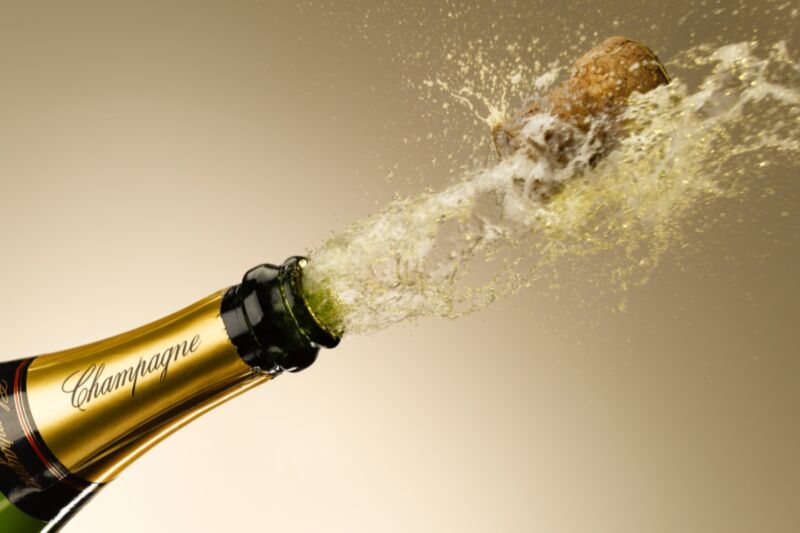size matters —
A 3-liter jeroboam can age for as long as 132 years before going flat.
Jennifer Ouellette
– Jul 28, 2023 10:59 pm UTC

Enlarge / French physicist Gerard Liger-Belair studied CO₂ levels in 13 old champagne vintages in three different bottle sizes.
Andy Roberts/Getty Images
A large part of the pleasure of imbibing a glass of champagne comes from its effervescence: all those bubbles rising from the glass and ticking the nose and palate. If there’s no fizz, there’s no fun—and also less flavor and aromas to savor. A recent paper published in the journal ACS Omega found that the size of the champagne bottle is a key factor in determining when the wine inside will go flat.
As we’ve reported previously, champagne’s effervescence arises from the nucleation of bubbles on the glass walls. Once they detach from their nucleation sites, the bubbles grow as they rise to the liquid surface, where they burst. This typically occurs within a couple of milliseconds, and the distinctive crackling sound is emitted when the bubbles rupture. The bubbles even “ring” at specific resonant frequencies, depending on their size, so it’s possible to “hear” the size distribution of bubbles as they rise to the surface in a glass of champagne.
Prior studies have shown that when the bubbles in champagne burst, they produce droplets that release aromatic compounds believed to enhance the flavor. Larger bubbles enhance the release of aerosols into the air above the glass—bubbles on the order of 1.7 mm across at the surface. French physicist Gerard Liger-Belair of the University of Reims Champagne-Ardenne is one of the foremost scientists studying many different aspects of champagne and has now turned his attention to exploring how long champagne can age in the bottle before the carbonation dissipates to the point where those all-important bubbles can no longer form.
Per Liger-Belair et al., champagne and other sparkling wines undergo a second in-bottle fermentation process called “prise de mousse” to ensure the beverages are saturated with carbon dioxide. Vintners add selected yeast and a bit of sucrose to start the process in bottles already filled with a base wine. These are then sealed with a crown cap or cork stopper and the bottles are stored in cool cellars. The seals prevent yeast-fermented CO₂ from escaping so it can dissolve into the wine.
For champagne, this is then followed by a second aging period of a minimum of 15 months, known as “aging on lees,” which enables dead yeast cells to be in contact with the wine, imparting additional distinct flavors and aroma profiles. Per Liger-Belair, there’s a common misconception, even among champagne enthusiasts, that the wine should not age beyond this point, but this yeast autolysis is a slow process, so higher-quality champagnes are allowed to age on lees even longer. “Old vintages of the finest champagne wines can even age on lees for several decades before finally being disgorged to expel the dead yeast sediment and then put on the market,” the authors wrote.

Enlarge / In the cellar of Champagne Castelnau (Reims, France), vintage bottles and magnums were stored for years in wooden racks in the upside-down position for prolonged aging with the yeasty sediment in their necks.
G. Liger-Belair et al., 2023
But there’s a downside to this very long maturation phase. While the crown caps and cork stoppers used to seal bottles of champagne are impermeable to liquids, gases like CO₂ can still slowly diffuse through them, particularly since the internal pressure is close to 6 bars at 12° C. This can decrease the concentration of dissolved CO₂ in the wine, reducing the number and size of bubbles in the glass and that all-important carbonation bite when the bottle is finally opened for drinking. In other words, the champagne gradually loses its fizz.
This could potentially affect the nearly 1 billion champagne bottles of different sizes and capacities currently aging in cellars. which includes hundreds of thousands of prestigious cuvées undergoing prolonged aging on lees. Furthermore, most bottles sealed before the 2000s have crown caps covered with cork discs, which are more prone to CO₂ leakage.
So Liger-Belair and his co-authors decided to determine the contributing factors of the shelf life of champagne in hopes of figuring out how to extend it. They partnered with Champagne Castelnau in Reims, France, which donated a collection of 13 old vintages: 1996, 1995, 1993, 1992, 1989, 1987, 1986, 1985, 1982, 1981, 1979, 1976, and 1974, demonstrating prolonged aging on lees spanning 25 to 46 years. After a few years of aging, the bottles were stored in wood racks in the upside-down position so that the yeasty sediment accumulated in the necks. All vintages except for 1974 were studied in three bottle sizes: the standard 750-milliliter, the 1.5-liter magnum, and the 3-liter jeroboam.
Liger-Belair et al. measured how much CO₂ was in each vintage, from which they could estimate the original amount of CO₂ produced by yeast. This revealed that the amount of CO₂ decreased the longer the vintages had been aged, with the 1974 vintage losing almost 80 percent. They also noted a correlation between CO₂ levels and a bottle’s volume. Specifically, larger bottles held on to CO₂ longer than smaller ones. The resulting formula they developed predicted a 40-year shelf life for 750-milliliter bottles, 82 years for 1.5-liter bottles, and 132 years for 3-liter bottles.
“For a cellar master, having chosen a 3-liter jeroboam to produce his champagne nearly triples the possible duration of aging on lees compared to that of the standard 750-milliliter bottle,” the authors wrote. “In view of their ability to produce CO₂ bubbles once they have been served in a glass, the shelf life of old champagne vintages is therefore definitely and strongly conditioned by the bottle size.”
DOI: ACS Omega, 2023. 10.1021/acsomega.3c01812 (About DOIs).
>>> Read full article>>>
Copyright for syndicated content belongs to the linked Source : Ars Technica – https://arstechnica.com/?p=1956510










